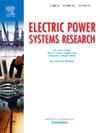SFA-EMT hybrid simulation of power systems: Application to HVDC systems
IF 4.2
3区 工程技术
Q2 ENGINEERING, ELECTRICAL & ELECTRONIC
引用次数: 0
Abstract
This paper presents the application of a novel hybrid multirate protocol to interface a Shifted Frequency Analysis (SFA) solution with an Electromagnetic Transients (EMT) solution. Using the Multi Area Thévenin Equivalent (MATE) framework, the protocol enables the direct interfacing of SFA and EMT solutions without time step delays, iterations, or the use of transmission lines to decouple the solutions. The protocol adds a parallel EMT solution to track both the real and imaginary parts of the EMT solution. This allows for a direct interface to the complex-number SFA solution. The proposed hybrid approach allows for large time steps in the SFA solution and does not require the time steps of the SFA and EMT systems to be multiples of each other. The protocol has been previously validated in a transient stability study, and it is applied in this paper to power electronics devices in the EMT subsystem using a modified CIGRE HVDC benchmark system. The use of SFA and the multirate nature of the solution offers significant computational savings for large power systems compared to an EMT-only solution.
电力系统SFA-EMT混合仿真:在高压直流系统中的应用
本文提出了一种新的混合多速率协议,将移频分析(SFA)解决方案与电磁瞬变(EMT)解决方案连接起来。使用Multi Area thsamvenin Equivalent (MATE)框架,该协议支持SFA和EMT解决方案的直接接口,而无需时间步长延迟、迭代或使用传输线来解耦解决方案。该协议增加了一个并行EMT解决方案来跟踪EMT解决方案的实部和虚部。这允许直接连接到复数SFA解决方案。提出的混合方法允许SFA解决方案中的大时间步长,并且不要求SFA和EMT系统的时间步长是彼此的倍数。该协议先前已在暂态稳定性研究中得到验证,并在本文中使用改进的CIGRE HVDC基准系统将其应用于EMT子系统中的电力电子设备。与仅emt解决方案相比,SFA的使用和解决方案的多速率特性为大型电力系统提供了显着的计算节省。
本文章由计算机程序翻译,如有差异,请以英文原文为准。
求助全文
约1分钟内获得全文
求助全文
来源期刊

Electric Power Systems Research
工程技术-工程:电子与电气
CiteScore
7.50
自引率
17.90%
发文量
963
审稿时长
3.8 months
期刊介绍:
Electric Power Systems Research is an international medium for the publication of original papers concerned with the generation, transmission, distribution and utilization of electrical energy. The journal aims at presenting important results of work in this field, whether in the form of applied research, development of new procedures or components, orginal application of existing knowledge or new designapproaches. The scope of Electric Power Systems Research is broad, encompassing all aspects of electric power systems. The following list of topics is not intended to be exhaustive, but rather to indicate topics that fall within the journal purview.
• Generation techniques ranging from advances in conventional electromechanical methods, through nuclear power generation, to renewable energy generation.
• Transmission, spanning the broad area from UHV (ac and dc) to network operation and protection, line routing and design.
• Substation work: equipment design, protection and control systems.
• Distribution techniques, equipment development, and smart grids.
• The utilization area from energy efficiency to distributed load levelling techniques.
• Systems studies including control techniques, planning, optimization methods, stability, security assessment and insulation coordination.
 求助内容:
求助内容: 应助结果提醒方式:
应助结果提醒方式:


